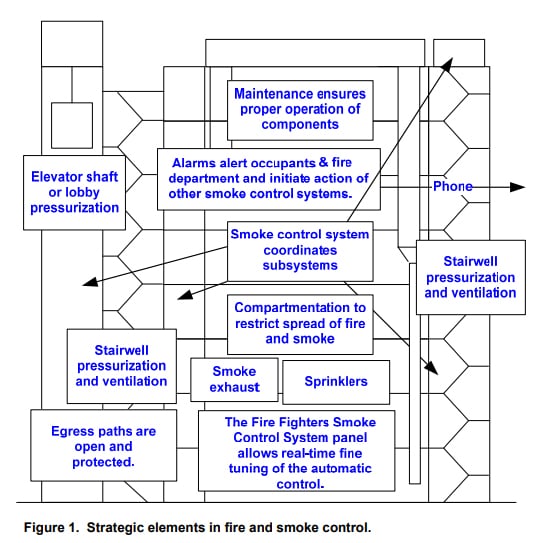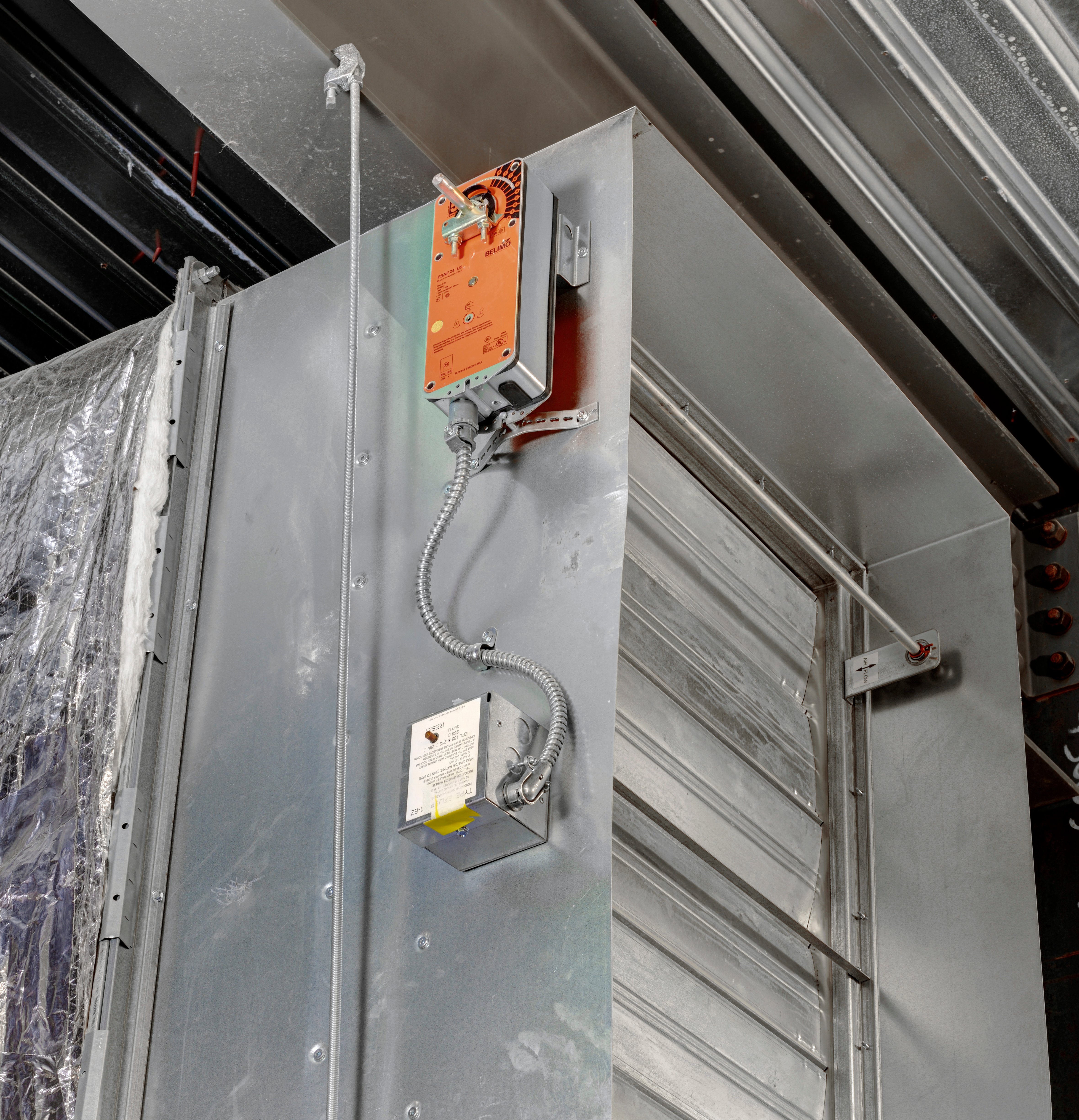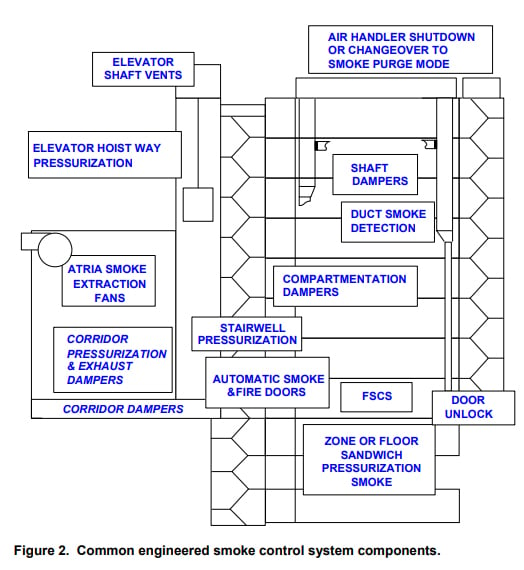Smoke Control Basics
The International Building Code (IBC. 2021) is the model for most building codes in the United States and some South American countries. Along with mechanical and fire codes, it defines the requirements for fire and smoke dampers and their operation during a fire. The various regulations have exceptions and specific instances in which one or more smoke control methods may or may not be required. The purpose of this blog is to explain how dampers operate and explain the technology to firefighters, fire prevention officers, code officials, consulting engineers, or building owners.
Chapter 3 of the IBC gives use and occupancy classifications, the different activities and uses that define, for example, a mercantile occupancy or high-rise business occupancy. Chapter 4 details requirements based on the classifications. Chapter 7 provides the requirements for construction, including fire and smoke dampers in barriers and walls. Chapter 9 covers the requirements for sprinklers, alarms, and smoke control systems. These chapters cover most of the code provisions for fire and smoke dampers.
Requirements in the code are based on experience either in building construction or lessons learned in past fires or disasters. Some cities and states have modified provisions based on the model codes with strong smoke control provisions. Seismic activity can tear gas lines from the ground, causing fire hazards while simultaneously breaking water lines, therefore disrupting sprinkler action.
Fire and smoke protection and life safety practices use available tactics. The strategy is the plan, and the tactics are the components of the mechanical systems. Fire alarms, sprinkler flow switches, and smoke control logic are primarily strategic methods, while sprinkler heads, ducts, fans, and dampers are tactical tools. In actual practice, the two blur together.
The Fire Fighters' Smoke Control System (FSCS) serves as the interface between strategy and tactics. Figure 1 illustrates the strategic elements. The design coordinates the various components in the system. For example, when the fire alarm is activated, the stairwell pressurization system is automatically turned on so that occupants can exit without being exposed to toxic smoke. The strategy involves several overriding concepts, the mix of tactics, the function of the code, and the fire protection engineers' design.
The fire alarm warns occupants of danger and the need to evacuate. External alarms alert the fire department. An announcement may be used to provide directions to occupants, especially in buildings with large footprints or high-rise buildings. Emergency planning and fire drills are required in many buildings. Egress paths from burning buildings allow escape and provide entranceways for firefighters. Exit lights & signs, corridor & stairwell smoke control, elevator pressurization, or lobbies protected by smoke barriers are all critical in egress.

Codes are not always clear about the primary function of smoke control. First and foremost is life safety. Protection of the building and furnishings from smoke damage is secondary. It is important to note that protecting property, particularly from collapse, protects occupants and firefighters who may be in the building after occupants have exited.
Sprinklers extinguish fires about 20% of the time and help control the spread of fires. Hidden or sheltered fires – particularly electrical fires in walls, fires that originate outside the building or the area covered by sprinklers, low water pressure, closed valves in water lines, explosions, and collapse of building structural elements can negate the operation of sprinklers. Smoke cooled by water or air-mixing can move down stairwells and open shafts. Smoke control complements sprinklers allowing clear egress paths where sprinklers cannot reach the fire. All fire dampers and about 85% of actuated smoke dampers maintain the integrity of fire and smoke barrier walls – they seal ducts and any large openings in fire and smoke compartment walls.
About 15% of actuated dampers are employed in engineered smoke control systems and control automatically unless the FSCS panel overrides to suffocate a fire or ventilate and purge smoke. Smoke control systems include pressurization of some spaces to stop the spread of smoke and exhaust fans for smoke removal; dampers direct airflow as necessary.
Fire prevention consists of any number of good practices, including periodic inspections, control of flammable materials, and isolation of fuel-burning equipment. Maintenance is critical to prevention, and deferred maintenance is a frequent danger.
The various tactics involve active and passive protection. Active protection methods include maintenance, sprinklers, fire and smoke dampers and doors, fire extinguishers, kitchen hood suppression, and exhaust fan systems. Passive methods comprise fire and smoke rated wall and ceiling compartmentation, structural component strength, and penetration fire stopping.
Homeland security measures can be passive or active. Barricades that prevent vehicles from proximity to the building and moving air handling intakes away from easy access by the public are passive, while sensors to detect toxins are active. A balanced strategy uses layered methods in parallel to achieve the same goal. Back-up systems protect against the failure of one method. For example, water pressure can be lost, but firewalls restrain flames' passage until the fire department can put water on the fire. Synergy is achieved using several methods.

Effective fire protection saves lives in the case of an emergency, helps minimize property damage, and secures continued operation. The best protection against the spread of fire and smoke through air ducts is provided by motorized fire and smoke dampers to create fire compartments. Belimo fire and smoke damper actuators automatically move into their safety positions to keep the dampers closed during a fire. Belimo fire and smoke damper actuators are designed for operation in smoke and combination fire and smoke dampers in ventilation and air conditioning systems with a torque range from 18 in-lbs to 180 in-lbs. For maximum safety in all situations, the fire and smoke actuators meet all codes for commercial buildings in the U.S., pass UL 555 & UL 555S, and are tested for 30,000 open-closed cycles with approved dampers.

Building Officials, Fire Marshals, Design Engineers, and Contractors are often asked to look at the details below the surface of an overall operation. Where devices and wiring interconnect two disciplines, there is a tendency for those involved to have only a fuzzy concept of the whole, interrelated design. Figure 2 shows some of the mechanical system components used in smoke control. Different tactics work together in a smoke control system to ensure compartmentation and automated means to manage the movement of smoke. When smoke is detected in an area, AHUs are often shut down. With an engineered smoke control system, it is as likely that all return air is exhausted outside, and fresh air is brought into the building. In large spaces such as atria, make-up air smoke dampers on outside walls (with ducts where appropriate) open to allow outside air to enter, replacing air and smoke pulled out by exhausts.
One of the most difficult challenges that planners, builders, owners, inspectors, and operators face is ensuring the safety of human life and property in buildings. Have you maintained periodic testing and taken corrective actions regarding your fire and smoke dampers? If a damper actuator does not pass your required test, contact a Belimo Sales Manager. Install needed replacement. Keep your occupants safe. Contact us today.


